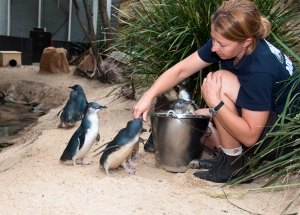Little Penguins are the smallest of the 17 penguin species found throughout the world. They stand at only 30cm tall and weigh only 1kg when fully grown, compared to their largest Antarctic cousin, the Emperor Penguin which stands up to 120cm tall and can weigh 40kg.
The name “Little Penguins” is now used instead of “Fairy Penguins” as it is a more accurate translation of their scientific name “Eudyptula minor”
These flightless seabirds are superbly adapted to the marine environment with a streamlined body shape Little Penguins experience the least resistance while swimming underwater. Their wings have evolved into flippers with which they propel themselves through the water, while on land they can be seen standing upright, waddling on their very short legs. The legs are also used while swimming underwater to steer
The dark feathers on Little Penguins are a rich dark blue not black like other penguins, and white on the underside and throat. This type of colouration is called countershading and is a form of camouflage. When seen from above, the penguin would be hard to see against the dark ocean while when seen from below, the white feathers blend in with the bright sky.
Little Penguins have an average life expectancy of 6 or 7 years, although some have been known to survive for 20 years. Here at Sydney Aquarium the ages of our penguins range from 5 weeks to 13 years. The penguin exhibit opened at the aquarium in 1997 with only 4 birds and now has a healthy colony of 12 penguins.
Little Penguins are found along the southern coast of Australia from Fremantle to northern New South Wales and New Zealand. They use to be fairly common on the Australian mainland, but these days due to humans and introduced animals their colonies are generally restricted to offshore islands.
Sydney is lucky to have a colony of Little Penguins in the harbour. The population once numbered in the hundreds but these days the number has decreased to about 60 breeding pairs. This population is the only breeding colony on the NSW mainland.
One of the largest known breeding colonies of Little Penguins can be found on Penguin Island in Western Australia with an estimated 1200 penguins and 500 to 700 breeding pairs.
Penguins are found only in the southern hemisphere so you will never see a penguin and a Polar Bear together in the wild.
The Little Penguins here at Sydney Aquarium dine primarily on fish such as pilchards and are fed at least twice a day. During the breeding season when our parent birds have chicks to raise this can be increased to 3 feeds.
In the wild Little Penguins feed by hunting fish, squid and other small sea animals, for which they travel and dive quite extensively. On average they dive no deeper than 2m and no longer than 20 seconds yet they are able to dive much deeper down to 60m and remain underwater for as long as 90 seconds.
Little Penguins may swim 15 to 30km a day searching for small fish to eat with studies recording one penguin travelling 100km in one day, but during breeding season they generally feed within 15km of the nesting site.
Little Penguins reach sexual maturity at the age of three to four years. They are monogamous and remain faithful to their partner over successive years though they will find another mate if their current one dies. They also tend to return to their nesting site where they hatched and continue to do so over successive years to breed.
Little Penguins usually nest in burrows and often set up their colonies in sand dune vegetation, among rocks and in caves. In Australia, the strongest colonies are on cat-free and fox-free islands.
The breeding season for Little Penguins usually starts between June and September when they lay one or more clutches of two eggs. Both parents sit on the eggs over a period of five weeks after which two chicks often hatch, but usually only one is raised unless food is abundant. For the first 15 days of its life, one parent will remain with the young chick while the other goes in search of food. After this, the chick is left alone while both parents go fishing. Chicks leave the nest to go to sea once they reach the age of 8 or 9 weeks.
Since 1997 Sydney Aquarium has successfully breed and raised over 45 Little Penguins. Some of these have been used to boost the current population while others have been moved to other institutions as part of a breeding program.
In 1996 Sydney Aquarium was involved in a Little Penguin Breed and Release Program with NSW National Parks and Wildlife. This involved the release of five penguin chicks, bred at the Aquarium, into the Sydney Harbour colony, with their establishment in the colony still being monitored.
Sadly a penguins’ greatest threat is humans. Their numbers have declined since European settlement. They die from our discarded plastic rubbish and fishing line, oil spills, cars and boat strikes. Other impacts include people trampling their nest sites, loss of suitable habitat and destabilisation of fore dunes (which may prevent penguins from accessing nest sites).
On land introduced animals such as foxes, cats and dogs have had a severe impact on birds nesting on the mainland and colonies are now largely confined to offshore islands.
At sea their are many dangers for Little Penguins such as natural predators like sea lions, sharks and birds of prey too rough weather and fish shortages.
Lastly, some important penguin facts…
WHAT DO PENGUINS HAVE FOR LUNCH? “ICEBURGERS”
WHAT DO YOU CALL A PENGUIN IN THE DESERT? “LOST”
WHAT KIND OF FISH DO PENGUINS CATCH AT NIGHT? “STARFISH”
🙂

